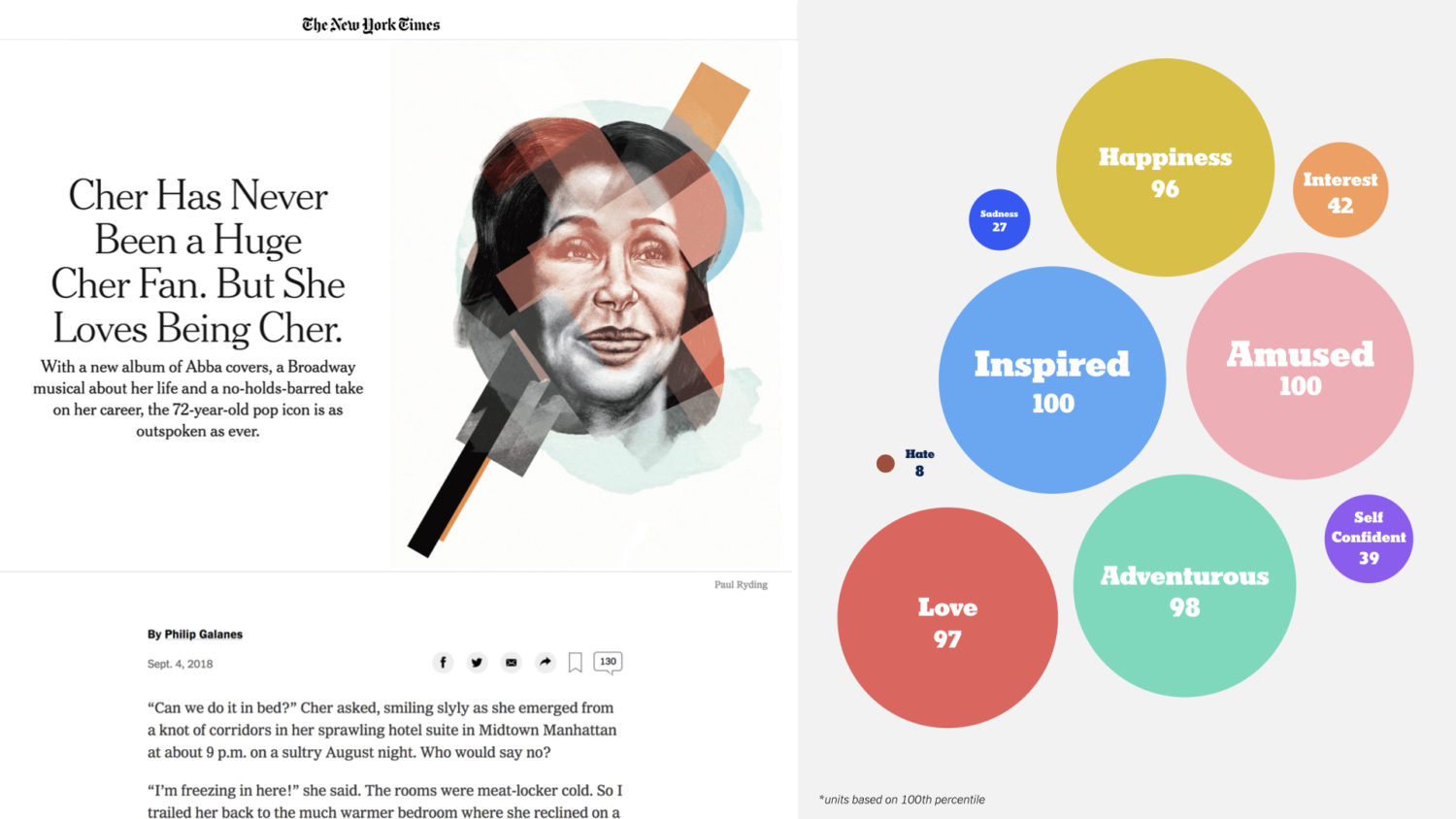A year ago, without ceremony, The New York Times piloted ad placements based on the emotions certain articles evoke. “Project Feels” has now generated 50 campaigns, more than 30 million impressions and strong revenue results (the Times declines to specify how much).
So it’s a hit, and the sort of advertising innovation based on data science, artificial intelligence and algorithm that the Times expects to scale up — and that other news organizations are exploring.
To take an example of what the Times more formally is calling “perspective targeting,” an interview/profile of Cher was determined to put the reader into an inspired, amused and adventurous mood. Should those feelings be a fit to an advertiser’s pitch, a placement automatically drops into the digital edition of the story.
Unlike those ads that stalk you across the internet based on what you have read and looked at, the connection will typically be invisible to the reader.
Here is how the futuristic-sounding product was developed and how it works:
- The Times began by asking a volunteer group of readers to choose from a list of 18 emotions that they felt as they read a sample of Times stories.
- With 150,000 data points, an analysis team could identify articles with strong emotional resonance. The resulting algorithm then instantly finds which combination of emotions is evoked as the story is posted.
- The Times and its advertisers can track with some precision whether the ad outperforms a more random placement. Some have generated as much as 80 percent more impressions than regular behavioral targeting. The average lift is 40 percent. That success supports a premium charge.
- The offering also includes “neutrality targeting”: that is, isolating upsetting stories that could decrease receptivity to ad messages — placements to be avoided.
At a glance this may sound a bit manipulative and “Brave New World”-like to consumers of news.
Journalists and other news purists may also wonder whether the Times newsroom is now being tasked with producing lots of emotional stories.
Neither is the case, Allison Murphy, senior vice president of advertising innovation, told me in an interview. The newsroom turned out plenty of emotionally charged stories, anyhow. So it has done nothing different. The ad sales initiative “doesn’t influence what is covered” and editorial integrity is not compromised.
And the “Project Feels” ads are actually less intrusive, she argues, since they do not depend on the sort of information about you and your preferences that cookies harvest.
Together, Murphy said, the two kinds of “Feels” targeting are a match to rising privacy concerns. They also provide “an original type of brand safety” at a time when advertisers need to worry about landing next to objectionable content on platforms like YouTube or Facebook.
To date, the most popular advertiser categories have been entertainment and corporate social responsibility messages. The first of the Feels sales was to a story evoking “adventurous” and aligned with a client’s launch of a new science fiction series.
“Self-confident” was paired with a message centered on women’s empowerment. Ads to date have also appeared across 10 other categories.
Of the 18 available emotions, 14 are positive. But even negatives like sadness or indignation, Murphy said, could support a given cause or candidate. “Boredom” isn’t and won’t be much of a seller.
Here’s the list:
- Optimistic
- Inspired
- Self-Confident
- Amused
- Adventurous
- In the mood to spend
- Love
- Sadness
- Boredom
- Interest
- Fear
- Hate
- Hope
- Happiness
- Nostalgic
- Indulgent
- Competitive
- Informed
I asked whether Project Feels might be exported as a franchised service to other news organizations.
“Generally no,” Murphy replied. “The whole model is based on Times content, and it requires maintenance. … We are very fortunate to have the resources to invest in this sort of innovation.” That includes both “the breadth of our content,” she added, and the sophistication to do a rigorous measure of what works and how well.
However, other organizations are already playing in the same sandbox and more will follow. A Digiday story on Project Feels last summer noted that ESPN can target ads depending on whether a given fan’s team is winning or losing. USA Today has a version called Lens Targeting with stories graded on the mood likely to be evoked.
As Murphy’s job title suggests, perspective targeting is not a one-off but part of a series of innovation projects. She was involved in the development of Flex Frames, a premium full-screen display that works on any device. Next she is planning a variant of Feels to get at motivation.
More broadly, the industry has been seeing data analysis generating models that can match story choices to a target audience’s greatest “passion topics” or can guide strategy for digital subscription paywalls and pricing.
I am not saying emotional targeting and its algorithmic cousins are the Holy Grail of a new business model — but they can’t hurt.









I haven’t seen an advertisement on the NYT in years, they can’t track me and I have all their shenanigans blocked. Funny, how the Poynter person cozily chats with the NYT privacy-buster-in-chief as if it’s a yawner that websites ruthlessly bust privacy and sell personal information, as if it’s all in a day’s work. Seems to me the ‘responsible journalism’ touted here would dictate Poynter inform Little People how to evade the privacy-busters, rather than get us used to the idea we have no privacy left…
I am with Next Digital, we are Hong Kong and Taiwan’s largest newspaper/online media group. (feel free to check AC Nielsen, Comscore, Alexa). The journalism being driven by these new subscription techniques is what I call “Subscription Journalism”. We write for the subscribers. NYT is the best I have seen and knows their prospective subscriber better than most. And we should not be arrogant about this development. Ailes at FOX pioneered then MSNBC followed and CNN is a poor second. In online and Print we have HUFFPOST, VICE, VOX, Daily Beast, and also Daily Caller, Hot Air, Drudge.
No one needs to win it all, but rather there needs to be a set niche. NYT with 5 million subscribers lives forever. Yet, lets call it for it what it is. NYT has many disappointed left leaning readers after Mueller, and maybe a few prizes that need to be returned. But do they correct course and move on? I would say no. Stay with what the audience wants, which is trying to deliver Trump’s scalp.
Subscription journalism is the new norm. We write for an audience that will pay.